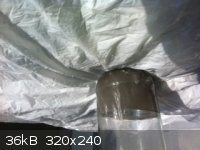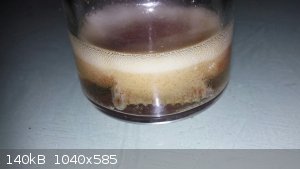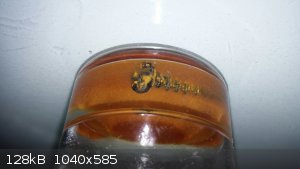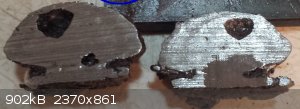| Pages:
1
2
3 |
AJKOER
Radically Dubious
    
Posts: 3026
Registered: 7-5-2011
Member Is Offline
Mood: No Mood
|
|
Neil:
Here is a paper you once referenced me too. My favorite quote from the first page is "Aluminum and Al alloys are passivated in neutral solutions, so
they have better corrosion resistance. However, the passivation film over Aluminum and Al alloys is easily destroyed in solutions containing active
anions, such as Cl"
LINK:
http://proj3.sinica.edu.tw/~chem/servxx6/files/paper_7425_12...
So I am guilty of replacing the word "destroyed" with "dissolved", and technically speaking, you are most likely correct. Good point, as it helps
explain the actual process.
I say most likely because in the case of a very acidic (or basic) salt, the pH may be sufficient to actually dissolve any dislodged Al2O3, as Alumina,
per my source, does dissolve in a strong acid or base. As an example of the latter, a known serious incompatibility is reported to exist between
Aluminum metal and Ferric (or Ammonium) Sulphate in the presence of moisture.
[Edited on 20-2-2012 by AJKOER]
|
|
|
White Yeti
National Hazard
   
Posts: 816
Registered: 20-7-2011
Location: Asperger's spectrum
Member Is Offline
Mood: delocalized
|
|
Nowhere in the paper did the author mention sodium chloride as a strong acid or base.
"Ja, Kalzium, das ist alles!" -Otto Loewi
|
|
|
AJKOER
Radically Dubious
    
Posts: 3026
Registered: 7-5-2011
Member Is Offline
Mood: No Mood
|
|
White Yeti:
I see your point that someone may incorrectly infer that I meant that NaCl is such a salt. As to how to best describe a NaCl solution, please see the
discussion at this link:
http://www.chemicalforums.com/index.php?topic=19886.0
I have since edited my comment with examples of highly acidic salts.
|
|
|
Neil
National Hazard
   
Posts: 556
Registered: 19-3-2008
Member Is Offline
Mood: No Mood
|
|
http://en.wikipedia.org/wiki/Credential

For more on the pH of NaCl solutions
Attachment: Effect of NaCl and HCl on pH.pdf (66kB)
This file has been downloaded 723 times
More on the pH of NaCl under CO2
Attachment: measuring NaCl pH.pdf (34kB)
This file has been downloaded 801 times
It is indeed funny how rare it is for people on this forum to admit to errors. 
|
|
|
weiming1998
National Hazard
   
Posts: 616
Registered: 13-1-2012
Location: Western Australia
Member Is Offline
Mood: Amphoteric
|
|
Quote: Originally posted by Neil  | Quote: Originally posted by AJKOER  | OK, salt, water and air. But, to add some chemistry, for example, NaCl allows the pitting of Aluminum as it dissolves the protective Al2O3 by raising
the pH followed by the hydrolysis of Al in H2O:
2 Al + 6 H2O ---> 2 Al(OH)3 + 3 H2 (g)
Now, in the case of Iron, it is CO2 dissolving the Iron:
Fe + 2 CO2 + 2 H2O ---> Fe(HCO3)2 + H2 (g)
and with air:
2 Fe(HCO3)2 + 1/2 O2 + H2O ---> Fe(OH)3 + 4 CO2
the rust forms. However, be careful to not raise the pH via NaCl with limited air flow as you will also form Iron carbonate:
Fe(HCO3)2 ---Elevated pH--> FeCO3 (s) + CO2 (g) + H2O [2]
|
?
NaCl solutioms do not dissolve Al2O3. The Cl is able to penetrate the Oxide layer to allow the Al underneath to react via electrochemical oxidistion
just like the pitting of Iron by chloride ions. Molten NaCl will flux Al2O3, is that what you are thinking of?
|
Just what I think about how salt water attacks aluminum slowly over time:
1 mole of salt solution disassociates into 10^-7 moles of both
HCl and NaOH. They react, but more soon disassociates. When you put aluminum in, they both attack the Al2O3, albeit very slowly, forming AlCl3(aq) and
NaAlO2/some Al(OH)4 ions. As the oxide layer is very thin, it is soon destructed by the trace HCl and NaOH, and reacts with the water+the trace
HCl/NaOH. The reason why NaAlO2 isn't formed is because the HCl reacts with it in water, forming more NaCl and Al(OH)3. The AlCl3 is reacted with the
NaOH and similarly, forms the same products as above. At the end, what you are left with are flakes of Al(OH)3.
|
|
|
Neil
National Hazard
   
Posts: 556
Registered: 19-3-2008
Member Is Offline
Mood: No Mood
|
|
No, they do not touch the Al2O3. It remains and the corrosion form blisters underneath it. The chloride ions set up a cycle of moving through the
Al2O3 barrier and attacking the Al underneath. The swelling of the material is able to break and blister the outer skin of Al2O3 but it sure as heck
100% is not dissolving it to form aluminates and the like. Rubies and Saphire do not dissolve in strong or weak NaCl solutions.
Chloride penetrates the barrier it does not dissolve, or destroy the barrier.
|
|
|
elementcollector1
International Hazard
    
Posts: 2684
Registered: 28-12-2011
Location: The Known Universe
Member Is Offline
Mood: Molten
|
|
I've had an odd experience with attempting to make red iron oxide.
(Unbalanced) reactions: Fe + H2SO4 -> Fe2(SO4)3 + H2
Fe2(SO4)3 + NaOH -> Na2SO4 + Fe(OH)3
Fe(OH)3 -> Fe2O3 + H2O
A few problems occured after step 2:
1) Filtering. This is a common problem for ferric hydroxide, as I've heard.
2) As the filter cake was drying, needle-thin crystals appeared, quickly drying the rest out. I assumed these were sodium sulfate and washed and
refiltered the precipitate (which was by now easy to filter because it was so dry and clumpy)
3) The filter cake is now a reddish-black powder, and upon heating with a (bad) hotplate, there is no color change or loss of mass. I can't use the
blowtorch because it's broken for some reason, and given that I am still living with my family, the oven is obviously not an option. Ideas?
The powder does look like it might be ferric hydroxide, and despite the dark color is not magnetite (no attraction whatsoever to a stirbar magnet).
Elements Collected:52/87
Latest Acquired: Cl
Next in Line: Nd
|
|
|
blogfast25
International Hazard
    
Posts: 10562
Registered: 3-2-2008
Location: Neverland
Member Is Offline
Mood: No Mood
|
|
A couple of points.
Fe is NOT oxidised to ferric sulphate by H2SO4, only to ferrous sulphate (FeSO4). H3O+ === > H2 just doesn't have
that kind of oxidising power.
But by now all Fe will have air oxidised to Fe2O3, so no real worries there.
Fe(OH)3 can be a barstool to filter because of possible peptisation. It occurs when the ionic strength of the wash water becomes low. The whole thing
can then (sometimes) simply run through the filter in one fell swoop. Very annoying. 
Ferric oxide's colour ranges from ocre to almost black, depending on mode of preparation. Colour is a poor marker.
Dry, even semi-calcinate, the product by heating it on top of your kitchen cooker on high heat in a disused steel pan (NOT aluminium, OBVIOUSLY),
using an old steel spoon as stirring rod. I've done this and it works well...
[Edited on 18-6-2013 by blogfast25]
|
|
|
Fantasma4500
International Hazard
    
Posts: 1677
Registered: 12-12-2012
Location: Dysrope (aka europe)
Member Is Offline
Mood: dangerously practical
|
|
i have a question...
now we can choose to do electrolysis.. OR using HOCl formed in several different ways or even creating FeSO4 by reacting it with H2SO4
now what im wondering is... why dont you guys just combine it??
when i was obtaining Cr(OH)2 by HCl + steel i usually kickstarted it with electrolysis, its a different thing but still metal etching with corrosive
liquids
steelwool in HOCl solution could possible act as a neutral meaning it would take part in the reaction, only thing that must not be allowed to happen
is contact with cathode or anode
i obtained 20g Fe2O3 through electrolysis in just water as i remember it, long procedure and more than just messy
|
|
|
ElizabethGreene
Hazard to Others
  
Posts: 141
Registered: 15-10-2012
Member Is Offline
Mood: No Mood
|
|
I have manufactured, found, and bought Iron Oxide.
I've personally manufactured rust two ways.
First, and most satisfying, is to light fine steel wool on fire. Steel wool is painfully expensive for this though. I paid $3.50 for 12 pads of it
yesterday, and they couldn't weigh more than an ounce or two. On the other hand they are a convenient source if you can nick your mom's used brillo
pads from under the sink and scrub the soap and grease out of them .
Second, I've manufactured it by electrolysis. Two iron electrodes, placed in a mason jar, with an unspecified quantity of salt added, and connected
to a 12 volt automotive battery charger. This ran for a week. The first couple of days seemingly nothing happened, but an oily sheen developed on
top of the water. On days 3-6, the water turned light green. This was filtered and allowed to dry whereupon the product turned red. The quantity
produced was infinitesimal.
I apologize for my lack of detail on this, it was before I started taking proper notes. One lesson learned was to keep your power supply wires OUT of
the water or they will disappear a lot faster than your target iron.
I "found" Iron Oxide in my shed where a plastic bin of masonry nails had filled up with water from a leak. Filtering the water gave
a bit of nasty impure rust. Drying the nails and then "tumbling" them in a 2 liter plastic bottle produced a fair amount of rust powder.
Finally, I bought Iron Oxide from Mid-South Ceramic Supply for $4.00 per pound for 5 pounds. This company was on my drive home from
work and this was by far the easiest way I've ever found to get rust. I found them by searching the internet for "Ceramic Supply near Nashville
Tennessee." They also have Tin/Titanium/Aluminum/and Nickel oxides and Barium/Copper/Lithium/Magnesium/Strontium Carbonates. The most unfortunate
bit about them is that it appears I'm going to be spending a fair amount of money there. 
Back to Aluminum powder for a moment. I inquired about this at a Sherwin-Williams paint store and they were unfamiliar with the substance. Could
someone be slightly more specific as to what kind of paint store to find this in?
Thanks,
Elizabeth
|
|
|
blogfast25
International Hazard
    
Posts: 10562
Registered: 3-2-2008
Location: Neverland
Member Is Offline
Mood: No Mood
|
|
Quote: Originally posted by ElizabethGreene  | Back to Aluminum powder for a moment. I inquired about this at a Sherwin-Williams paint store and they were unfamiliar with the substance. Could
someone be slightly more specific as to what kind of paint store to find this in?
Thanks,
Elizabeth |
Here in the UK some model [RC planes, RC cars, dolls' houses etc] shops stock it as a filler for metallic paint or die cast resins. You might find it
also in some paint-for-crafts shops.
|
|
|
Dr.Bob
International Hazard
    
Posts: 2659
Registered: 26-1-2011
Location: USA - NC
Member Is Offline
Mood: No Mood
|
|
Back to Aluminum powder for a moment. I inquired about this at a Sherwin-Williams paint store and they were unfamiliar with the substance. Could
someone be slightly more specific as to what kind of paint store to find this in?
Years ago, paint stores would mix up, make, or modify paint. Now they get cans of white paint and tint it with a machine that likely is likely
smarter than the people operating it. But few places actually mix things together to make paint unless the machine does it for them. So it is much
harder to find raw pigments and paint chemicals now in stores. If you can find an OLD paint store, they might have some left, likely hidden on a
shelve in back. Ask the oldest person there for help...
And clearly, buying iron oxide is a simple solution or just finding old rusty things and shaking them well. Using nails or other small pieces of
iron will rust plenty fast with some water, salt, and maybe bubble some air through. If you scaled that up a bit, you could generate lots of rust
for nearly nothing. You might be able to find a hardware store with some old, rusty nails that got wet that are discounted because of that.
Letting nature do its thing is a great way to do chemistry.
|
|
|
blogfast25
International Hazard
    
Posts: 10562
Registered: 3-2-2008
Location: Neverland
Member Is Offline
Mood: No Mood
|
|
Quote: Originally posted by Dr.Bob  | Back to Aluminum powder for a moment. I inquired about this at a Sherwin-Williams paint store and they were unfamiliar with the substance. Could
someone be slightly more specific as to what kind of paint store to find this in?
|
Almost none, I should think.
Al powder, probably depending on where you are, isn't hard to get though. Amazon and eBay UK both advertise it. Pyro webstores offer more grades than
I care for. It's not OTC but it's not problematic either.
|
|
|
AJKOER
Radically Dubious
    
Posts: 3026
Registered: 7-5-2011
Member Is Offline
Mood: No Mood
|
|
OK, upon further studies in the electrochemistry of batteries, there is, in effect, an iron air battery (see visuals at https://www.google.com/search?q=iron+air+battery&tbm=isc... ).
As such, in my opinion, a better description of the reaction of Iron and an oxygen source (like, for example, H2O2 in place of O2) is better described
as electrochemical process. Assuming an electrochemical reaction similar to the that of Zinc and Oxygen in aqueous NaCl (see http://sci-toys.com/scitoys/scitoys/echem/batteries/batterie... ), the reaction, in part, could proceed as follows with Iron, Aluminum, H2O2 and
NaCl :
At the Iron anode:
Fe + 2 OH- ⇒ Fe(OH)2 + 2e- (see Eq [1] at http://jes.ecsdl.org/content/159/8/A1209.full )
and:
H2 + 2 OH- ⇒ 2 H2O + 2 e- (See Eq [2] above reference)
Cl- + H2O ⇒ HCl + OH-
At the Aluminum strip (cathode) we could have:
H2O2 + 2 e- ⇒ 2 OH-
Na+ + OH- ⇒ NaOH
As the NaOH and HCl recombine forming NaCl, its chief role here is to transfer charges, that is, acts as an electrolyte.
A significant side reaction forming Fe2O3.xH2O is:
2 Fe(OH)2 + H2O2 --> 2 Fe(OH)3
Now, as to whether this is an effective manner to prepare Fe2O3, I tested a reaction mixture of an piece of Iron in a NaCl + a dilute H2O2 solution in
an aluminum pan. Within an a few hours, an obvious formation of a rusty water solution.
I also tested the reaction of Al pieces and a chunk of Iron in a solution of NaCl, NaOCl and vinegar (a so called Bleach battery if you substitutes Cu
for Fe). Again, within a few hours an even more obvious formation of a fine rust suspension in water. This latter battery cell also forms,
unfortunately, a significant amount of Chlorine.
Added references please see http://www.exo.net/~pauld/saltwater/ and also http://www.dtic.mil/dtic/tr/fulltext/u2/d019917.pdf
[Edited on 26-10-2013 by AJKOER]
|
|
|
AJKOER
Radically Dubious
    
Posts: 3026
Registered: 7-5-2011
Member Is Offline
Mood: No Mood
|
|
Quote: Originally posted by AJKOER  | .......
Now, as to whether this is an effective manner to prepare Fe2O3, I tested a reaction mixture of an piece of Iron in a NaCl + a dilute H2O2 solution in
an aluminum pan. Within an a few hours, an obvious formation of a rusty water solution.
I also tested the reaction of Al pieces and a chunk of Iron in a solution of NaCl, NaOCl and vinegar (a so called Bleach battery if you substitutes Cu
for Fe). Again, within a few hours an even more obvious formation of a fine rust suspension in water. This latter battery cell also forms,
unfortunately, a significant amount of Chlorine.
....... |
I thought some follow-up observations may be of interest.
On the Fe, H2O2, NaCl in an Aluminum pan despite what I thought was a thick pan, it soon developed 2 small holes. I transferred the solution to a
glass vessel with a strip of Aluminum. The reaction proceeded but apparently requires replenishing of the H2O2 for good rust production (a side
comment, this probably odes badly for Aluminum boats in oxygen rich salt water in contact with Iron).
The reaction of a solid piece of Iron and Aluminum in a solution of NaCl, NaOCl and vinegar does initially appear more efficient, as of the next day,
a clear presence of a rust and a brown solution, albeit with a strong Chlorine presence. Fast forward a few days, and because of the presence of Al,
the solution appeared to take on a pure metallic (Al or Fe?) appearance. The following day, the solution developed a more brown hue. My speculation,
the replacement by Al of an Iron chloride, forming colloidal Iron that with my shaking on 1st observing the metallic appearance has since formed some
Fe2O3.
I will repeat the experiment, but if correct in my speculation, this is a relatively simple and inexpensive path to colloidal Iron or Iron oxide.

[Edited on 29-10-2013 by AJKOER]
|
|
|
AJKOER
Radically Dubious
    
Posts: 3026
Registered: 7-5-2011
Member Is Offline
Mood: No Mood
|
|
I should have thought more simply, like an Iron air battery. I added an old screw that was starting to demonstrate some corrosion to a solution of 3%
H2O2 and NaCl (actually, I used sea salt which has been described as a better electrolyte than ordinary salt). Then, a few seconds in the microwave.
Wow! A very vigorous reaction that continued for 5 minutes (consumed the H2O2, I suspect). The product was a colloidal suspension of Fe2O3.xH2O that
eventually (around 10 minutes) forms into a fluffy thick layer. Cool!
This iron oxide hydrate is, I suspect, also somewhat reactive given its surface area and should serve well in preparing a catalyst.

[Edited on 6-8-2014 by AJKOER]

|
|
|
sbreheny
Hazard to Others
  
Posts: 145
Registered: 30-1-2014
Member Is Offline
Mood: No Mood
|
|
I've had very good luck making thermite using powdered aluminum from eBay suppliers and red iron oxide (Fe2O3) also from eBay. It is cheap and easy.
You can get a pound of each for about $5. Magnetite (black iron oxide) is some kind of matrix of both Fe2+ and Fe3+ ionic species with oxygen. I have
not compared the performance of the two but I can definitely confirm that red works very well. I believe that I used a mesh size of between 600 and
1200 for both and the reaction was spectacular and produced beautiful globs of iron (see photo for the largest glob, about 40 grams, sawed in half to
show the almost solid iron interior).
Quote: Originally posted by pROcon  | Ceramic supplier. They have really nice fine mesh. There's black, red and brown iron oxide.
What the difference is I don't know, more complete oxidation for black, least for red I'd guess. Black might contain the most oxygen for the
fuel-oxidizer mix?
A hotter burn.
|

|
|
|
| Pages:
1
2
3 |